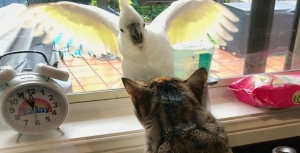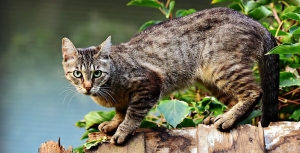Displaying items by tag: cats
Initiative to keep cats safe at home
The Ku-ring-gai Bushcare Association (KBA) came up with the idea to run a competition to encourage cat owners to keep their cats inside and protect wildlife. Residents were provided with information about the risks to wildlife and cats if they are allowed to roam outside. They were invited to submit photos of their cat safely inside and have a chance to win a $500 voucher to install cat enclosures for their pets. Over 130 entries were submitted so it was a difficult task to select the winners.
The competition was funded through an Environmental Levy Grant and was a partnership between Ku-ring-gai Council, Catnets and KBA.
The KBA was established in 1994 to represent bushcare, streetcare and parkcare volunteers at Ku-ring-gai Council. The KBA committee meets monthly with council to provide input into native vegetation management issues and assist with organisation of activities such as convenor forums.
Domestic cats and dogs pose a serious threat to wildlife
Domestic cats and dogs pose a serious threat to wildlife because of their natural hunting instincts. With a large number of unowned (stray and feral) and free-roaming cats and dogs, it’s important to manage domestic pets to minimise the damage that can be done to other, more vulnerable species.
It’s difficult to estimate the impact domestic cats have on wildlife, however studies suggest a suburban domestic cat can kill and bring home anywhere from 5 to 30 native and non-native animals each year.
Pet owners should:
- keep cats inside, even if it’s just at night when native animals are most active
- keep dogs inside at night, or confined to a secure space on the property
- provide a safe environment for wildlife in their garden and encourage a wildlife-friendly backyard
- identify pets with a collar, tag or microchip
- add collar bells for cats
- de-sex their pets
If a pet brings in an animal, if possible take it straight to a vet. The saliva of dogs and especially cats, contains bacteria that is toxic to wildlife. It is known amongst WIRES carers and rescuers that animals bitten by a cat or a dog have a small window (usually a few hours) where antibiotics must be administered, or the animal is unlikely to make it.
Lizards such as Blue-tongues often reside in backyards and can have around 15 gardens within their territory. It is likely the lizard has lived in the area for some time and is adept at avoiding hazards such as cats and dogs. However the rescue office receives a large number of calls for Blue-tongued Lizards who have sustained injuries such as puncture wounds or broken backs from domestic animal attacks.
This article has been contributed by Andrew Little. It is a transcript of presenter notes by Jess Styan, WIRES Rescue and Care of Wildlife on the North Shore, as part of WildThings NSW Forum on Sunday 15 October 2023.


